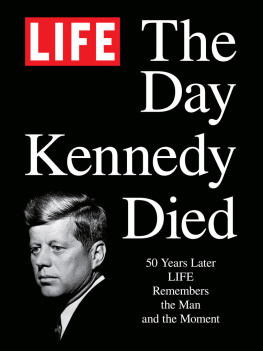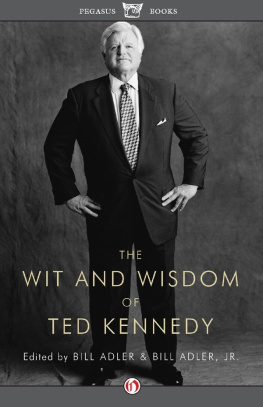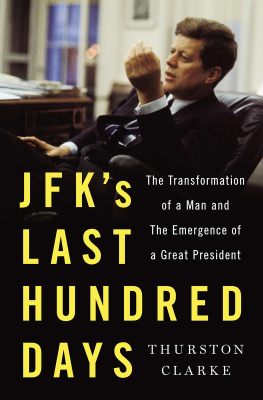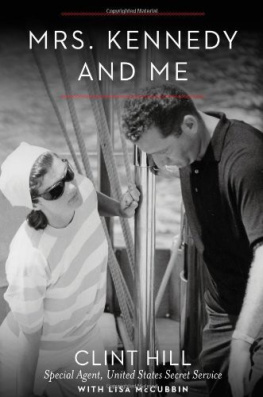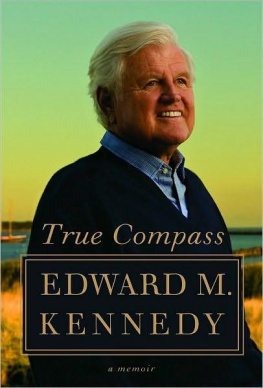 | Simon & Schuster
1230 Avenue of Americas
New York, NY 10020 |
Copyright 2009 by the Boston Globe
All rights reserved, including the right to reproduce this book or
portions thereof in any form whatsoever. For information, address
Simon & Schuster Subsidiary Rights Department,
1230 Avenue of the Americas, New York, NY 10020.
SIMON & SCHUSTER and colophon are registered trademarks of Simon & Schuster, Inc.
Library of Congress Cataloging-in-Publication Data
Ted Kennedy: scenes from an epic life / by the photographers and writers of the Boston Globe
p. cm.
1. Kennedy, Edward Moore, 1932 2. Kennedy, Edward Moore, 1932Pictorial works.
3. LegislatorsUnited StatesBibliography. 4. United States. Congress. SenateBiography.
I. Boston globe.
E840.8.K35T425 2009
973.92092dc22 2008046870
[B]
ISBN-13: 978-1-4391-4872-3
ISBN-10: 1-4391-4872-4
Title Page Image : Four years later, leading the cheers along the parade route.
BOOK STAFF
EDITORS: Janice Page, Thomas F. Mulvoy Jr.
ART DIRECTOR: C. Linda Dingler
WRITERS: Thomas F. Mulvoy Jr., Carol Beggy
RESEARCHERS: Liberty McHugh Pilsch, Bruce Pomerantz, Lisa Tuite, Richard Pennington, Richard J. Dill, Stephanie Schorow, Megan McKee, Leslie Sampson, Susan Vermazen
IMAGING: Ray Marsden, Jerry Melvin, Frank Bright, Liberty McHugh Pilsch, Bruce Pomerantz, Leslie Sampson, Dorian Color
Visit us on the World Wide Web:
http://www.SimonSays.com
Foreword
by Senator John Kerry
Theres a revealing contradiction in this photographic project because the life, the liberalism, the love, and the lossthe story of Ted Kennedyhas never stopped at the frames edge.
The Kennedy family will forever be associated with the words of Tennyson; but perhaps more than any other, its Ted who gave new life to the old poets line, I am a part of all that I have met. No portrait of Ted Kennedy is complete without all those whose lives are forever enriched by his lifes workthe sick, the poor, the elderly, the disabledfor whom, as the Boston Globe once declared, in actual, measurable impact on the lives of tens of millions of working familiesTed belongs in the same sentence with Franklin Roosevelt.
And theres something unmistakably genuine, beautifully private, wholly authentic that word overused in American politics but thoroughly Ted in every wayin the fact that this giant touched so many of those lives when the cameras were nowhere to be found. There are countless stories of friends who, facing a grim diagnosis, found Ted Kennedy personally working the phones to doctors across the globe on their behalf; of political adversaries and ideological opposites who benefited from Teds compassion, men like George Wallace, who found Ted Kennedy intimately involved in his rehabilitation from a paralyzing gunshot wound; and the folks Ted met along the waythe child in a wheelchair whose hand Ted held for a long while in the hall of the Russell Senate Office Building on his way to a vote; the old man from Leominster, Massachusetts, oxygen tank by his bedside, whom Ted stopped to sit with in the hospital time after time; and, yes, the straggly haired, angry Vietnam vets facing possible arrest and political threats from the Nixon administration, whom Ted visited in April 1971, while other prominent politicians stayed away.
To appreciate fully the greatness of Senator Ted Kennedy is to understand that behind each snapshot, there has always been a heroic steadfastness. Behind the liberal lion who roaredgloriouslythe dream shall never die is a lifetime spent in tireless service to the creed that circumstances may change, but the work of compassion must continue. Day after day, decade after decade, Ted Kennedy has lived and legislated according to this creed, amassing a record of groundbreaking legislation equal to that of any United States senator in 232 years of American history.
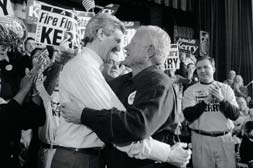
Campaign workers: Senator John Kerry has Teds support at a rally in Iowa during his 2004 presidential run.
Behind each flash photograph of Ted smiling, surrounded by dignitaries, heads of state, fellow politicians, brothers and sisters, cousins and nephews, there are countless stories of dear and faithful friendship. On Inauguration Day 2005, it was Teddy and Vicki who arrived first at my familys home in Washington and lightened a day wed all hoped might have been different. Each photograph of a warm embrace is testament to a friend who was always there by our side when the sun wasnt shining, but who seemed alwaysfor our benefitto have the sunlight in his face, that beaming smile and unmistakable baritone. Among his not-so-secret weapons have always been great humility, good humor, and a genuine affection for friends and strangers alike. His brother Robert once said that all great questions must be raised by great voices. Teds singing notwithstanding, the cause of American idealism knows no greater voice than that of this youngest Kennedy brother.
These photos capture his journey from the youngest of nine children to the patriarch and custodian of American liberalism and also our nations journey from the new frontier to new hope to the audacity of hope. It is the long, impressive, and enduring story of a great American life.
John F. Kerry has represented Massachusetts in the U.S. Senate since 1985 and was the Democratic nominee for president in 2004. A high school volunteer for Kennedys first Senate race in 1962, Kerry became reacquainted with Senator Kennedy in 1971 as a Vietnam veteran testifying against the war before the Senate Foreign Relations Committee. In January 2009, Kerry became the committees chairman.
Introduction
By Martin F. Nolan
At the movies, Americans watched Lawrence of Arabia and To Kill a Mockingbird ; the Boston Celtics won their fourth straight championship; Rachel Carson wrote about a new concern, pollution, in Silent Spring . And in 1962, Edward Moore Kennedy was elected to the United States Senate, where he has served longer and, in the opinion of many historians, more effectively than most.
Damon and Pythias, Castor and Pollux. Mythical heroes often come in pairs. But in America, ever since John Francis Fitzgerald went to Congress in 1895, the public has been fascinated by a vast tribe of Kennedys. They remain at center stage in the twenty-first century. In a saga mixing Greek tragedy and soap opera, press coverage has often been dominated by sycophants or haters. During the Ted Kennedy decades, the Boston Globe took neither sidenot out of virtue but because posturing is unnecessary. This man is news, in season and out.
In 1965, when he tried to win a federal judgeship for a friend of his fathers, the Globe documented the nominees sketchy legal career. Many in the Senate and in the Johnson administration had their doubts, but Kennedy persisted. So did the Globe . After he withdrew the nomination, the senator was unhappy with his hometown paper.
Bob Healy, the editor who led the investigation, defined a reporters code: If you tag a guy, be sure to show up that day to hear about his beefs. So Healy, fellow reporter Jim Doyle, and I went to Kennedys office, entering through a staff door, as we normally did. Instead of legislative assistants, we were confronted by the senator, surrounded by aides, all fuming and growling. One of them wordlessly removed his PT-109 tie claspthe badge of Kennedy loyaltyand hurled it. I caught this souvenir and still have it. In 1966, the judgeship stories won the Globe its first Pulitzer Prize. Kennedy congratulated members of the prize-winning team, saying, You couldnt have done it without me!



